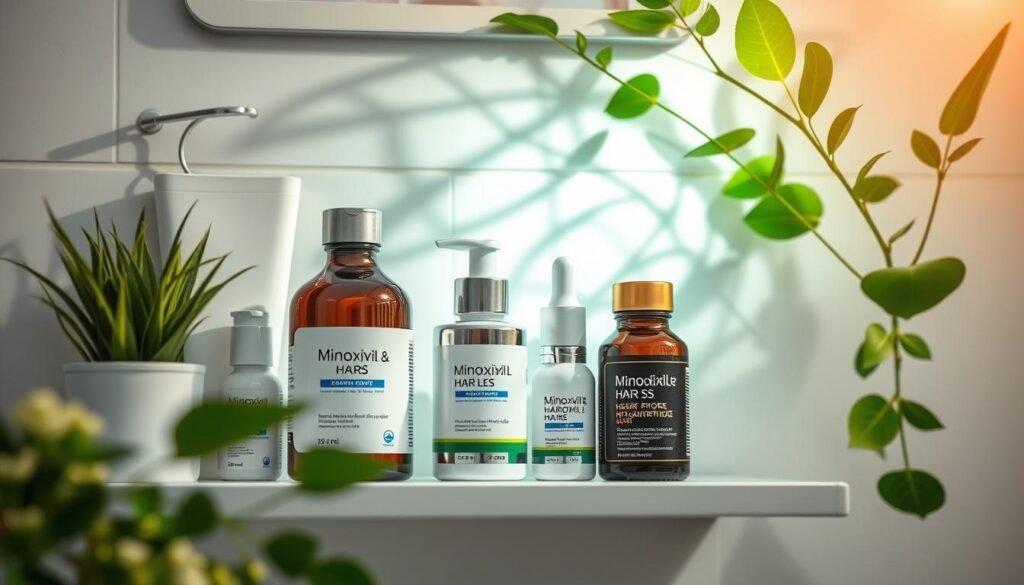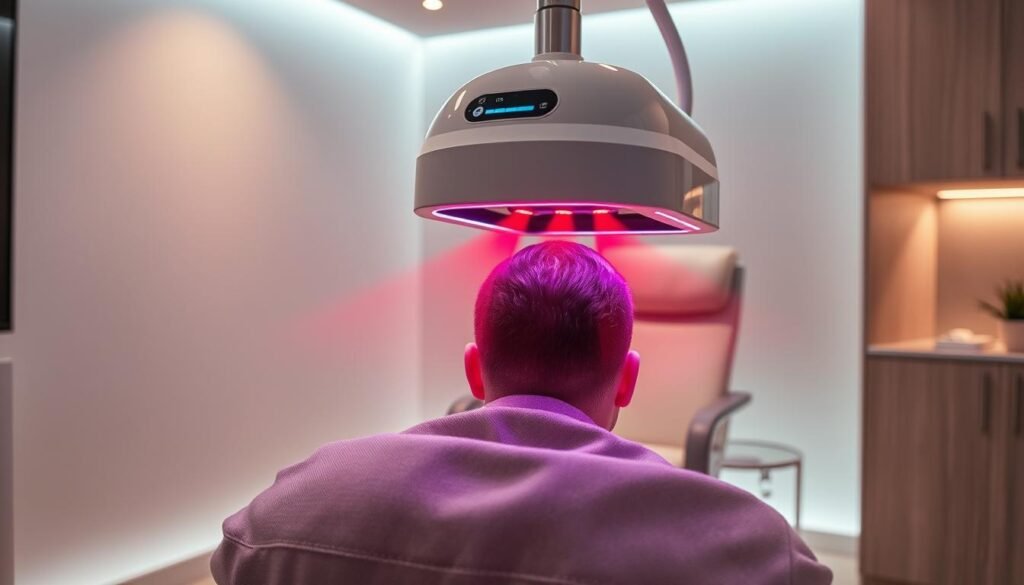Did you know that by their 50s, nearly half of all men and women face patterned hair loss? In the U.S., this problem affects about 50 million men and 30 million women. This issue, often related to aging, genetics, and hormonal changes, can really affect self-esteem.
There’s no complete cure for a receding hairline, but there are effective ways to handle it. Options include FDA-approved drugs like finasteride and minoxidil, along with natural remedies. Lifestyle changes and proper hair care are also key to promoting hair growth. Let’s look into the best treatments for hair loss and how to deal with this common problem.
Key Takeaways
- Almost 50% of both genders experience a receding hairline by their 50s.
- Genetics and family history significantly contribute to hair loss patterns.
- FDA-approved hair loss treatments include finasteride (Propecia) and minoxidil (Rogaine).
- Natural remedies such as essential oils may aid in promoting hair growth.
- Adopting a healthy lifestyle can mitigate the effects of a receding hairline.
- Low-level laser therapy has emerged as an effective option for hair regrowth.
Understanding the Causes of a Receding Hairline
A receding hairline can really worry a lot of people. It’s important to know what causes it to manage it well. Things like your genes, hormones, and getting older can make it happen. Knowing about these can help people figure out the best way to deal with it.
Genetics and Family History
Genes play a big part in whether you’ll have a receding hairline. If your family has a history of hair loss, you might too. A condition called male androgenic alopecia is a common reason men lose hair. It affects half of all men by the time they’re 50.
This hair loss can look different in men and women. Men might start losing hair above their temples. Women might see it thinning where they part their hair, moving toward the temples.
Hormonal Changes and DHT
Hormonal changes can also lead to a receding hairline. DHT, a type of testosterone, plays a big role. High levels of DHT can make hair follicles smaller. This makes your hair thinner and might even stop it from growing. Women go through hormonal changes, especially during menopause, that could cause hair loss too.
Aging and Its Effects
Getting older is naturally linked to losing hair. Our hair grows slower as we age, and it might get thinner or stop growing. By 50, many men will see some hair loss. This is just part of aging but knowing this can help us plan for it.
| Factor | Description | Impact on Hair Loss |
|---|---|---|
| Genetics | Family history influencing hair loss patterns | High susceptibility, particularly in men |
| Hormonal Changes | Fluctuations in hormone levels, especially DHT | Shrinking hair follicles, leading to quicker hair loss |
| Aging | Natural decline in hair growth capability with age | Increased likelihood of thinning and receding |
Effective Hair Loss Treatments
Looking for effective hair loss solutions is crucial for people facing hair thinning. There are many treatments available, from medicines to surgeries. Each method has its own advantages and things to consider. This helps people choose the best path in their quest for fuller hair.
Medications: Finasteride and Minoxidil
Finasteride and minoxidil have proven effective for many battling hair loss. Finasteride, known as Propecia®, is a prescription drug for men. It targets the hormone DHT, which is linked to hair loss, helping to maintain hair. Studies show it halts hair loss in 90% of cases. It even regrows hair in two-thirds of users.
Minoxidil, on the market as Rogaine®, is an over-the-counter choice for hair regrowth. It works well for those with thinning hair on top of their head. About 66% of men have success with minoxidil. Starting treatment early boosts the chance of good results.
Platelet-Rich Plasma (PRP) Therapy
PRP therapy is gaining fans as a way to grow hair. It involves taking platelets from your blood and injecting them into the scalp. This method uses the body’s growth factors to wake up hair follicles. PRP therapy is a low-risk option that can improve hair thickness and health.
Hair Transplants: Pros and Cons
Hair transplants are a permanent fix for hair loss. In this surgery, hair is moved from where it’s thick to where it’s not. The biggest plus is getting natural, long-term results. However, it’s costly and comes with surgery risks. Thinking about what you really need and expect can help you decide if a hair transplant is right for you.

| Treatment | Type | Effectiveness | Considerations |
|---|---|---|---|
| Finasteride (Propecia) | Prescription Medication | Slows/stops hair loss in nearly 90% of users; regrowth in 66% | May cause side effects; long-term commitment |
| Minoxidil (Rogaine) | Over-the-Counter Medication | Effective for 66% of men; best for early hair loss | Ongoing treatment required; potential scalp irritation |
| PRP Therapy | Invasive Procedure | Stimulates hair growth; varies by individual | Multiple sessions required; cost can add up |
| Hair Transplant | Surgical Procedure | Permanent solution; natural appearance | Higher cost; surgical risks involved |
Natural Remedies for Hair Loss
Natural remedies for hair loss are gentle options. They help promote hair health without just using medications. These options include essential oils and herbal treatments, which have unique benefits.
Essential Oils for Hair Growth
Essential oils are effective for hair growth and better scalp health. Peppermint and rosemary oils improve circulation to the scalp. This can lead to thicker hair. For instance, six weeks of using rosemary oil can match the effects of minoxidil.
Lavender oil also helps by encouraging growth. It slows down hair loss in people with alopecia areata. This makes essential oils a strong choice for healthier hair.

Herbal Treatments: Saw Palmetto and Ginseng
Saw palmetto is known as a natural blocker of DHT, a cause of hair loss. A 2020 study showed that 83.3% of people using it got denser hair. Also, 60% saw their hair quality get better.
Korean red ginseng could also make hair thicker and denser. It helps hair follicles enter a growth phase. Mixing ginseng with aloe may make it even more effective for the scalp.
These natural remedies are promising for healthier hair and tackling hair loss issues. For more information on these solutions, you can check it out here.
Hair Growth Supplements
Exploring hair growth supplements offers insight into enhancing hair health. These products have vitamins, minerals, and extracts for stronger, radiant hair. Brands like Viviscal and Forti5 show promising results. Still, we should view their claims with caution due to limited independent research.
Biotin and Its Benefits
Biotin is a key ingredient in these supplements. It helps develop healthier hair. A lack of biotin can lead to hair loss. This makes biotin-rich supplements vital for hair vitality. Their prices vary, making them accessible to different budgets.
Vitamins and Minerals for Healthy Hair
Hair health depends on the right vitamins. Important ones include vitamins A, C, D, and B. Not getting enough, especially of vitamin D, can cause hair loss issues like alopecia areata. Minerals like zinc and iron are also essential for healthy hair. Many products combine these with plant extracts for better hair care.
| Supplement Brand | Main Ingredients | Reported Benefits |
|---|---|---|
| Viviscal | Biotin, Fish Extract | Improved hair count and density. |
| Forti5 | Vitamins A, D, E, Zinc | Increased hair counts in 80% of users. |
| DrFormulas’ HairOmega | 43 ingredients including DHT blockers | Supports overall hair health. |
| Hello Lovely | Biotin, Multivitamins | Tasty gummy formulation for hair support. |
Adding hair growth supplements to your routine could help, especially with hair thinning. While early studies are encouraging, we need more research to fully understand their effect.
Low-Level Laser Therapy for Hair Growth
Low-level laser therapy (LLLT) has become a go-to for fighting hair loss without surgery. It uses certain light wavelengths to boost hair follicle health, leading to fuller hair. For anyone looking to tackle hair loss, understanding LLLT is key.
How Laser Treatments Work
During low-level laser therapy, lasers shine soft light on the scalp. This light goes deep into the skin, energizing hair follicle cells. This can repair damage from things like age and hormonal changes. To get the best results, you have to stick to a schedule. Most people see improvement after treatments of 8-15 minutes, 2-3 times weekly.
Effectiveness and Safety
A study in 2013 showed participants had a 39% increase in hair growth in 16 weeks. Research also says low-level laser therapy is safe for men and women. Even so, not everyone will see the same success, and some may not see much difference. The cost of clinical treatments can also add up, reaching thousands each year.

If you’re considering LLLT, it’s smart to talk to a professional first. Getting advice suited to your situation helps a lot. Joining support groups or seeking resources can also guide you through hair loss treatment. For more help and information, visit this resource.
Changing Your Hairstyle to Conceal Hair Loss
Trying out new hairstyles can be a great way to hide hair loss. Different styles for thinning hair not only look good but also boost confidence. It’s important to know which styles help cover thin areas and which ones to avoid for the best outcome.
Recommended Hairstyles for Thinning Hair
There are several hairstyles that are perfect for thinning hair. Some top choices include:
- Side-Swept Bangs: This style hides thinning at the hairline and brings a youthful touch.
- Top Knot: Great for curly hair, it covers thin spots on the top of your head.
- Buzz Cut: Good for various hair loss stages, it reduces the difference between hair and forehead.
- Volumizing Products: Sprays and gels can make hair look thicker, changing how it appears.
- Layered Haircuts: They add volume, especially near the face, and help with thin areas.
Styles to Avoid for a Receding Hairline
When picking hairstyles, it’s also important to know which ones could make hair loss worse. Avoid these styles:
- Tight Ponytails and Braids: These can pull at hair roots, possibly causing traction alopecia.
- Harsh Hairstyles: Tight styles can make thin areas more obvious instead of hiding them.
- Long, Flat Styles: These styles can show off thinning hair and make it look flatter.
Choosing the right hairstyle can boost your confidence. Knowing how to hide hair loss can help anyone with a receding hairline find a fitting look.
Scalp Care and Massage Techniques
Proper scalp care is key for healthy hair and can help with hair thinning and loss. Scalp massages boost blood flow. This can wake up hair follicles and may lead to new hair growth. Scalp massages are great for anyone looking to improve hair health.
The Benefits of Scalp Massages
Scalp massages are loved for making hair thicker and more vibrant. Studies show regular scalp massages can actually make hair thicker. After 50 hours of massage over a few months, many saw better growth in thin spots. These massages do more than grow hair. They also ease stress and feed the scalp nutrients.
Targeting thin spots can really pay off. Massaging 11 to 20 minutes each day has shown great results. This practice boosts blood flow. With more flow, the tiny vessels under the skin expand, helping hair roots.
To find out how massages help with hair growth, read this useful source.
Using Gentle Products for Hair Care
Alongside massages, using gentle hair products is vital. Picking natural products without harsh chemicals prevents harm. These products and massages together care for the scalp well. They keep the scalp happy and avoid irritation from strong products.
Pairing soft hair care and massages creates the perfect setting for hair to grow. If you’re into natural hair loss remedies, learning about certain herbs and home solutions may help. Check out this article for more insights.
Strategies to Maintain a Healthy Diet
A diet for healthy hair must be well-balanced. It helps in hair growth and keeps hair in good shape. Being low in essential vitamins and minerals can cause hair loss. So, it’s key to eat a mix of nutrient-packed foods every day. Foods rich in iron are especially needed. Lean red meat, leafy greens, and beans are good choices. Iron deficiency is common around the world and can lead to losing hair.
Foods That Promote Hair Growth
Iron isn’t the only nutrient that matters. Vitamin D, biotin, and zinc also support healthy hair growth. Research shows that about 80% of people with hair loss have low vitamin D levels. To get these nutrients, eat eggs, fatty fish, nuts, and avocados. Adding various foods for hair growth to your diet fights oxidative stress too. This stress can harm hair follicles.
The Role of Antioxidants in Hair Health
Antioxidants fight against cell damage from free radicals. Eating plenty of fruits and veggies provides important vitamins and minerals. It also boosts antioxidants for hair health. Berries, sweet potatoes, and leafy greens are packed with antioxidants. They help keep hair follicles healthy. A diet full of nutrients, along with staying hydrated, keeps your hair looking vibrant. It also reduces hair loss risk and gives lasting hair care results.